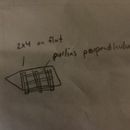Installing a New Roof Over Existing Roof
I am renovating an older house, and recently found out there are high levels of lead paint on the existing standing seam roof. I had originally planned to replace the roof, but now that we have a 2 month old baby in the house, I want to do as little disturbance as possible. The new plan is to encapsulate the existing roof with an encapsulating paint, and then use 2×4 and 1×3 strapping to form a base for a new metal roof on top of that. I would run the 2x4s flat, parallel with the seams, and then 1×3 strapping or purlins perpendicular to have a base for attaching new roofing. I guess I could use plywood instead of purlins, too. The attic space is uninsulated, and I had hoped to insulate it from above after taking the old roof off, but i’m not going there anymore. wanted to do that so we could leave the ceiling open inside. Im thinking my options now keep the ceiling, and install gable vents on either side. Is there a way to install exterior insulation with the new roof on top? we will have an 1-1/2″ air gap between the two roof layers – will that cause any issues ? how would one approach insulating something like this? possible to spray cellulose ontop of the drywall ceiling, but would be difficult to keep it from touching the rafters as it is only a 3:12 pitch. perhaps the new air gap will make it so that doesnt matter?
thanks!
GBA Detail Library
A collection of one thousand construction details organized by climate and house part










Replies
The kind of roof retrofit you're talking about isn't uncommon, there have been a few discussions recently.
I would think leaving the standing seam roof would cause more problems than it solves. It's a massive thermal bridge, if any part of it is exposed to outside air the whole thing is going to be cold. Second, you'll be much better off with a flat surface as your starting point.
You should be able to remove it without creating a superfund site. It's not going to have the kind of airborne lead dust that you get with grinding or sanding, if the paint is loose it will come off in flakes which are straightforward to contain.
If your house is that old you may want to test the soil in the yard. It's really common to find elevated lead levels in the soil from all the paint that flaked off over the years. Toddlers like to pick things up and put them in their mouths. Not an expert, but I believe a couple inches of dirt will encapsulate it.
we are in the process of soil testing as well! isn't it already a huge thermal bridge? would there actually be a difference?
Now it's on the exterior, it bridges the outdoors to the outdoors. If you put insulation above it, it bridges the outdoors to the indoors.
Would I be able to add rigid foam to the old standing seam layer? perhaps either smashing it down onto the seams, or cutting the first layer to fall within the seams? and then stagger layers on top of that to get 3" of polyiso? then 7/16 osb, roof underlayment, and new metal roof?
The problem with your metal roofing is that it extends to the exterior perimeter of the roof, and because metal conducts heat pretty well, it will short-circuit any insulation above or below it. You could cut the perimeter of the roofing away but leave the field in place; that would address the thermal bridging issue. But doing so is loud and makes a lot of sparks, not to mention making the lead paint into a fine airborne dust. If you could wrap the entire perimeter with insulation so the metal is not exposed to the air or cold temperatures, that would be an effective solution.
Re-roofing without stripping the old roof is always a hack job.
I left the shingles roof on my house, cut the overhangs off, and framed new rough sawn rafters with generous overhangs over the whole roof. I then spray foamed between the rafters, then installed zip decking and a new metal roof on top. This approach allowed me to leave the poorly insulated existing interiors intact, straightened the sagging roof, increased the overhangs and tied in to the addition I had built previously.
Installing a new roof over an existing roof can be a cost-effective solution for homeowners looking to update their roofing system without a complete tear-off. This method saves time and money while providing an extra layer of protection against the elements. It’s essential to ensure that the underlying structure is sound and can support the additional weight. Proper ventilation and drainage must also be considered to prevent moisture issues. For more resources and guidance on roofing projects, Visit MasterKreatif
I'd second what DC said above about reroofing on top of an existing roof being a hack job; although it seems like a bigger job on the face of it, removing the existing roof and starting fresh is likely to save you a lot of messing around down the line.
Removing your lead-painted metal roof sounds like something that you'd be able to tackle safely and effectively without creating a lot of dust. I understand the concern with having a young child around - lead exposure is a big deal for developing brains/bodies - but in general, working safely around lead paint isn't rocket science and is pretty easily accomplished by someone working diligently and conscientiously. It might be worth taking a lead-safe remodeler course, which will cover most everything you need to know.